All about the Flower
Distribution and Habitat
Rhododendron is a genus of the heath family (Ericaceae). In horticulture, Rhododendron is divided into two groups: One is Azaleas, which have smaller flowers and leaves and trichomes on their leaves and stems, and the other group is Rhododendrons, which have bigger flowers and leaves, without trichomes on their leaves and stems. While Azaleas mostly grow in the mountains at lower altitudes or at the water’s edge, Rhododendrons are mostly found in cold and wet mountain areas at higher altitude.
There are over 9,000 species of the Rhododendron genus around the world. With the centers of diversity at the foothills of the northern and southern Himalayas, these species are distributed east, west and southeast. China is the country with the greatest species diversity. Over 1/4 of the Rhododendron species in the world can be found in Yunnan, the southwestern part of China. Thus, Yunnan has earned the name of “The Rhododendron Garden of the World.” Moreover, Rhododendron simsii, the species native to the Yangtze River Basin, is the main parental species of Rhododendron x hybrida, and has hereditary features of an early florescence and a good adaptability to indoor conditions.
There are roughly 30 Rhododendron species in Taiwan, 26 of which are endemic, such as Rhododendron oldhamii Maxim, Rhododendron formusanum Hemsl, Rhododendron kanehirai, etc. During flowering period, mountain regions are reddened by these Rhododendrons in full bloom, like Hehuan Mountain in early summer and the Wuling Farm (close to Snow Mountain) in May. Due to the beautiful scenery of reddened mountains adorned by Rhododendrons, these flowers are also known as “manshanhong” or “yingshanhong” in Taiwan, which means “a whole mountain covered in red.” Different from the aforementioned species which are native to Taiwan, the Rhododendron that blooms in NTU and Yangming Park in March is an introduced species, Rhododendron mucronatum. Rhododendron mucronatum is a hybrid of Rhododendron simsii, the species native to Ryukyu islands, and the species native to Japan. Developed through a long time of plant breeding, the hybrid has bright-colored flowers, generally white, purple, pink and scarlet and so forth.
Reference Sources:
Lee, Nean. Rhododendron. Taipei: Chishing Afforestation Foundation.2001.
Plants of TAIWAN
Catalogue of Life in Taiwan
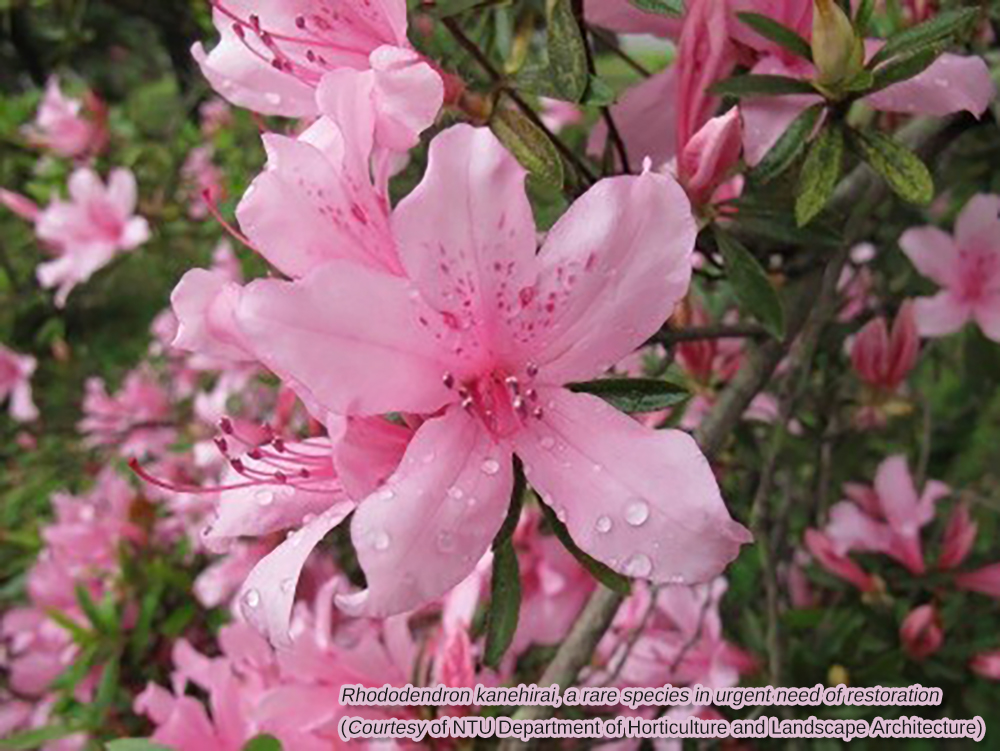
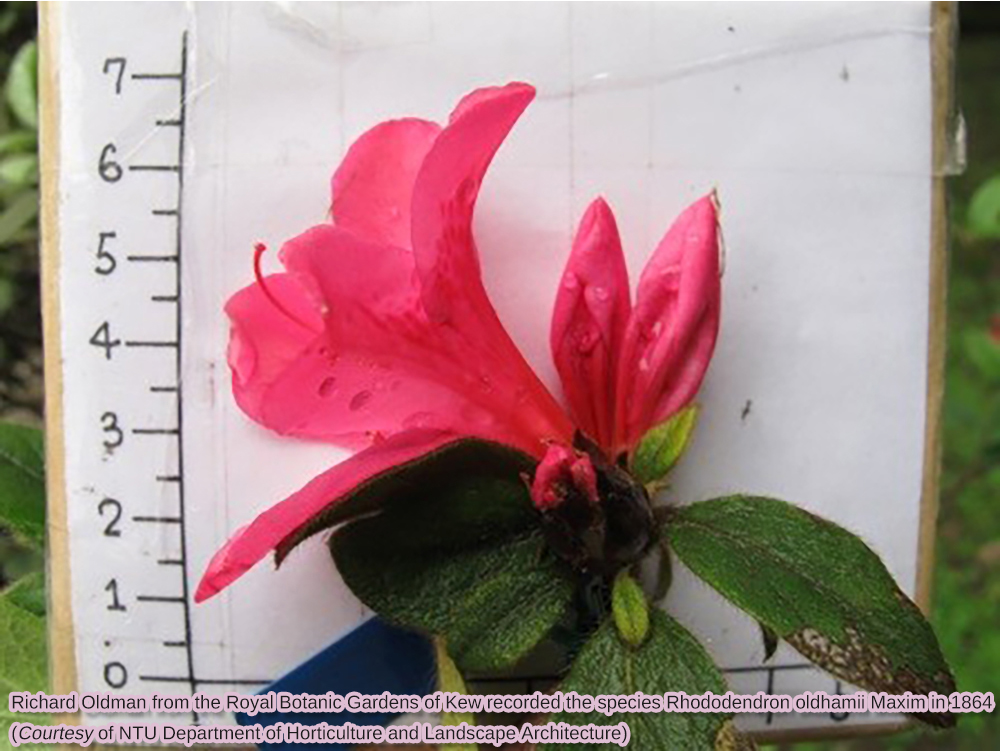
History of Azaleas
In the West, reports of azaleas can be traced back to 400 B.C., when the Greek armies were defeated by the Persian and retreated to the regions around the Black Sea and some Greek soldiers there by mistake consumed the honey made from some kind of yellow-flowered azalea nectars and got poisoned. Three hundred years later, soldiers of the Roman army ate the same kind of honey in the same region. The soldiers then passed out and were slaughtered. Due to these incidents, the medieval Europe started to study azaleas and found the medicinal potential of some azaleas. During the 18th and 19th century, European countries, with their expansion of sea power, introduced a great number of Rhododendron species native to China and Japan and conducted hybridization and plant breeding. Gradually, azaleas became common and important landscaping plants in everyday life.
On the other hand, in the East, in 492 A.D. during the Liang dynasty of the Northern and Southern dynasties, a Daoist master Tao Hongjin wrote a work of pharmacology, the Bencao jing jizhu (本草經集注, Collected Commentaries to the Materia Medica), where a vivid description of the toxicity of the yellow-flowered azaleas can be found. It is written in the Bencao jing jizhu that a goat lingered around and died after eating the leaves of the yellow-flowered azaleas. The yellow-flowered azaleas, thus, is also called “yang-zhizhu”(羊躑躅, goat lingers) today, and azaleas can be called “zhizhu” (躑躅, to linger). Another name for azaleas in Chinese is “du-juan” (杜鵑). Behind this elegant name lies a beautiful sad story. Legend has it that in ancient China, there was a king of the state of Shu named Du Yu, who was knowledgeable in farming and loved his people. After ruling the state for 200 years, he abdicated and lived in seclusion. However, he still cared for the people and the state, so every year in the third month on the lunisolar calendar he turned into a bird, flying around to urge people to sow their seeds during the farming season. The bird chirped nonstop till it spit blood on the flowers. To show their gratitude, the people named that bird “dujuan,” (杜鵑) to commemorate Du Yu and the flowers which the blood spilt on “dujuan hua” (杜鵑花,dujuan flower).
Reference Sources:
Lee, Nean. Rhododendron. Taipei: Chishing Afforestation Foundation.2001.
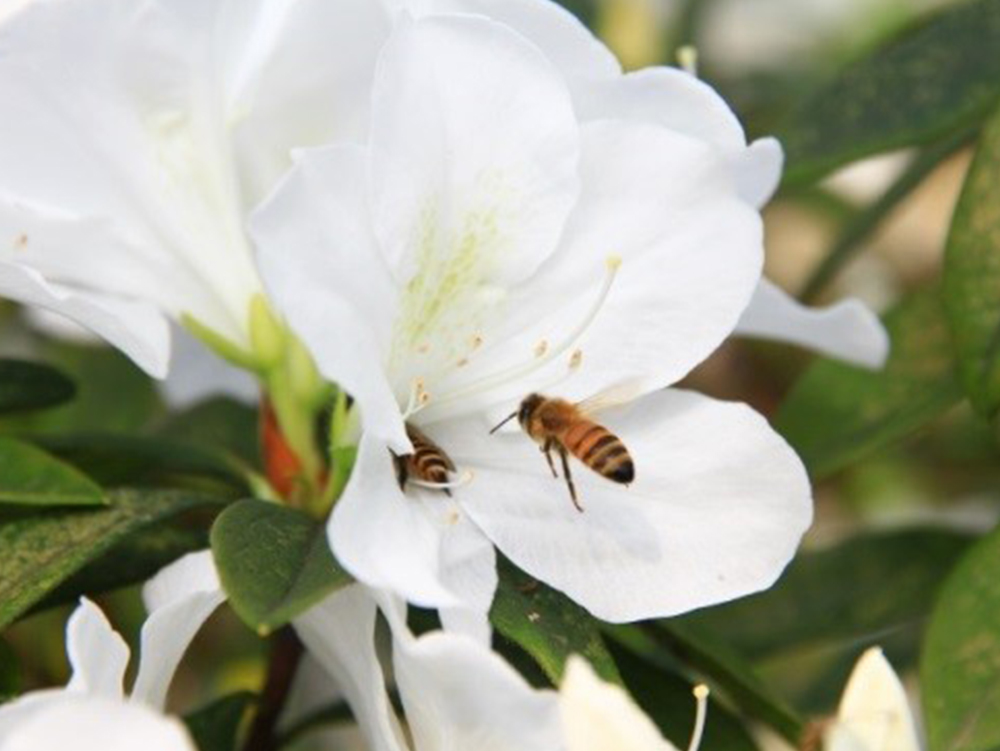
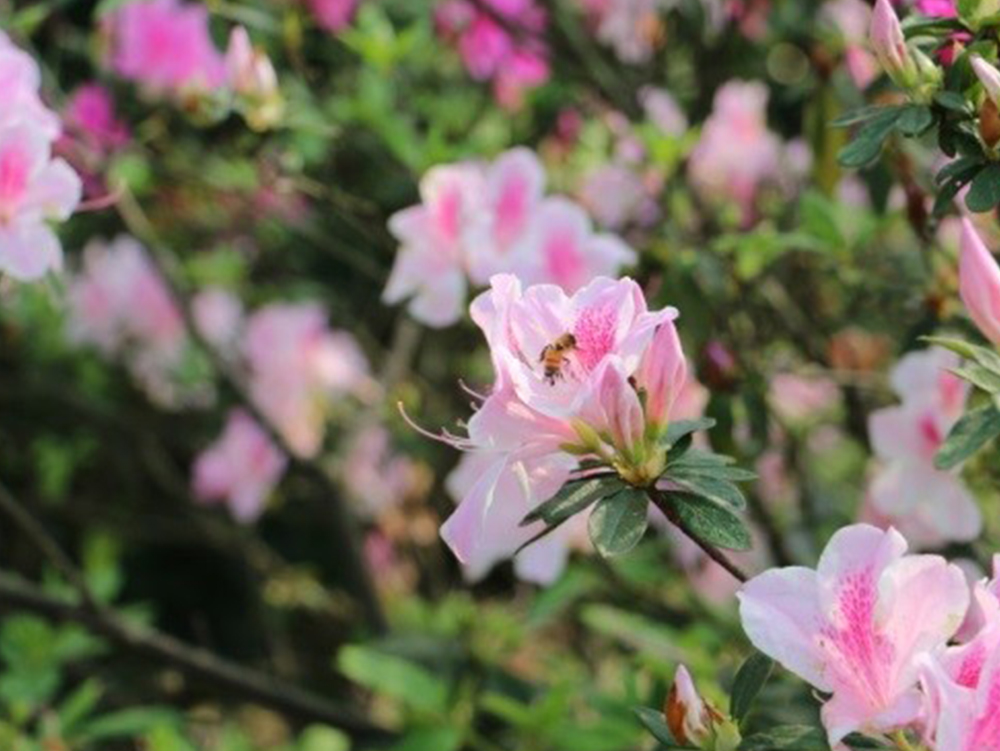
Azaleas in Artistic Works
Sad yet beautiful tales and colorful blossom of azaleas always serve as materials for literature. Literati of different times have praised the beauty of azalea with innate sensitivity and imagination. Azaleas have enriched our spiritual lives. Li Bai, the god of poetry, once wrote in one of his poems, “Seeing azaleas in the Town of Xuan,” that “Once in the Kingdom Shu I heard the singing of ziguis. Here in the Town of Xuan I saw the blossom of azaleas. Every time when the birds sang my heart broke with pain. Every spring when the flowers sprang I remembered my homeland.” The poet expressed his homesickness triggered by the sight of azaleas during a travel, borrowing the image of the brooding emperor, Du Yu, who died missing his homeland and turned into a bird called “Zi-gui” (also dujuan, with the same pronunciation for azaleas in Chinese). Bai Ju-Yi, another poet of the Tang Dynasty, also wrote poems about azaleas with famous sentences such as “Azaleas fall and dujuans sing. Old shrubs blossom the Red Lingering.” One of his contemporaries, Chen Yan-Xiong, also wrote that “There are blossoms and birds called ‘dujuan,’ heavy are their grief and redness. Once the blood was in the mouths, has dropped onto branches and turned into flowers.” Even in the Song Dynasty there was “Maple trees green along the Chu River. Red azaleas hurt the hearts of beholders” by Su Shi. These classic poems are as long-lasting as the azalea.
Du Pan Fang-Ge was a Taiwanese Hakka poetess. In her poem “The Woman Wearing a Bamboo Hat,” she used the azalea as a symbol of a Hakka woman’s youth and beauty. Azaleas were described as flowers with lovesickness dancing beautifully to attract the only sunshine in life. The spring azaleas in full bloom serve as a metaphor for the feminine charm of a young woman, demonstrating the universal image Hakka women that transcends space and time. Besides, the metaphor also connects the memory of hometown beyond space-time and presents the long-lasting vitality and prosperity of the Hakkas.
Wearing a bamboo hat,
The woman walks
To the boundless, distant, and indigo-dyed landscape,
Climbing mountain by mountain, and then to the ocean
Forward, forward,
Still forward to the high mountains, the high mountains forward.
Nearby Guangdong, the sun-shading black draping cloth of the “Hakka bamboo hat,”
Blown by the wind, brushing the land,
Flaps and flaps.
Suddenly the woman takes off the hat on her head and turns it over,
A virgin in love, a virgin like a bud.
The hat turned over is filled with cherry blossoms of early spring and azaleas in full bloom.
The woman walks seductively toward the sunshine,
From her hat, tossing all the beautiful spring flowers that seduce the sunshine one
By one.
Lin Yu-shan, one of the “Three Youths of Taiden,” directly incorporated the spectacle of azaleas into his poems. He wrote in “An Arbitrary Song of Spring,” that “It is in the pleasant weather of spring, when I meet friends, view flowers, and drink. The path winds along the Yangming Mountain, where amongst azalea shrubs I hear warblers’ singing.” How enjoyable it is! Does this remind you of any works or stir up any memory?
Reference Sources:
Lee, Nean. Rhododendron. Taipei: Chishing Afforestation Foundation. 2001.
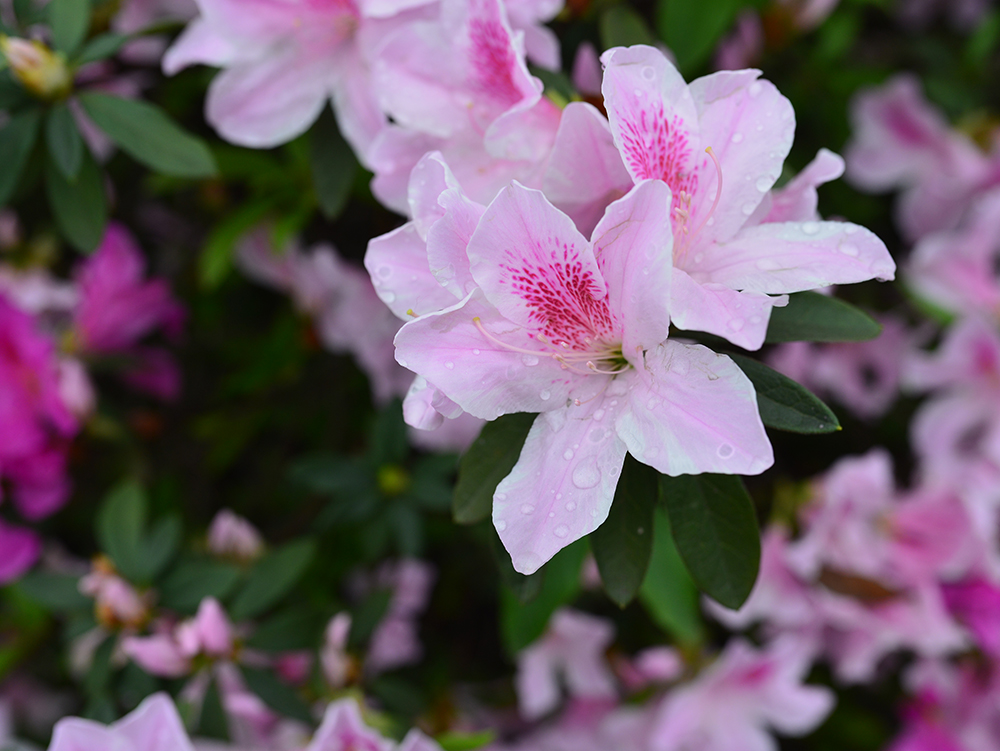

Greeting the Azaleas in the Taipei Metropolitan Area
Whether you think an ecological tour can acquaint you with our eco-system or our environment, or you simply need an escape from the busy life of the modern society, or even if you are just pretending to be a nature-lover, or for whatever reasons, as long as you have made up your mind to spend time, azalea is definitely one of the best choices for you in spring, either in the Taipei metropolitan area or the suburban mountain forests brimming with wild beauty.
To enjoy the colorful spectacle of azaleas, you must come to NTU, which has been beautifully nicknamed “the City of Azaleas.” The most common species of azaleas in NTU is Rhododendron mucronatum, and there are also precious “Rhododendron kanehirai,” “Rhododendron oldhamii Maxim,” which is a native of Taiwan, “ Rhododendron x hybrida,” and “NTU Hybrid Rhododendron.” Every year in March, these azaleas bloom and turn NTU into a riot of colors. The azalea is the city flower of Taipei. This year, the Taipei City government would like to promote “Taipei Azalea Season” and to beautify the city by planting azaleas. Thus, whenever you are walking on a street, just pay more attention and you will be surprised by the beautiful azaleas around you.
Going out of Taipei to the suburbs, you will find that Yangming Mountain, which Lin Yu-Shan once wrote about, is another great place for azalea-viewing. In Yangming Park, Azalea & Camellia Garden, Yangming Study, and Datun Nature Park, there are various species of rhododendron. For many “Yangming goers,” the Hu-shan road leading to the Yangming park is especially a must-go for rhododendron-viewing. It can be one of the best options for you, too. But if you are longing for more azaleas, you may go farther away from Taipei to NTUHEF (Highland Experiment Farm of National Taiwan University) in Xi-tou or Mei-feng. That would definitely be a rewarding trip!
Reference Sources:
Youngmingshan National Park/ Conservation & Education。
Digital Taiwan

